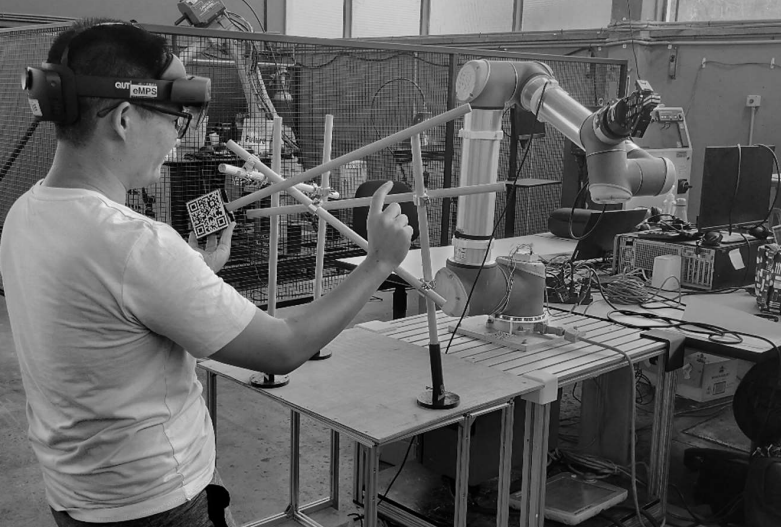
Exploring with augmented reality-enabled human robotic collaboration (AR-HRC) system: An Interactive Workshop with collaborative robot for lightweight structure
20th — 22nd April
10:00 AM — 4:00PM (SGT)
3 days
Think Tank 1
10 PAX
WEI WIN LOY
Queensland University of Technology
HAMIDREZQ RAFIZADEH
Queensland University of Technology
SHABNAM LOTIFAN
Queensland University of Technology
NAME
DESIGNATION
NAME
DESIGNATION
NAME
DESIGNATION
Day 3: AR in HRC
communicating with cooperative robotic arm using basic programming language.
Learn how to communicate with a cooperative robotic arm, UR10 using an AR interface.
Understand the capability and limitations of a cooperative robotic arm.
Explore how AR could be used to facilitate human-robotic collaboration (HRC) in exploratory
assembly tasks.
professionals, researchers, and robotic enthusiasts from various industries who are interested
in exploring the integration of collaborative robotics via augmented reality application for
creative design-fabrication process. Some experience with Rhino and Grasshopper is preferred
but not required.
– Prior experience with VR/AR headsets (e.g., Meta Quest, Vive, HoloLens, Apple Vision, etc.) will be preferred but not required.
– All participants will require a windows 10 laptop with up-to-date Rhinoceros 7 and Grasshopper
– An AR enabled mobile phone is preferable but not essential.
REGISTRATION CLOSES 18 APRIL 2024
INSTRUCTORS

WEI WIN LOY
PHD CANDIDATE: Queensland University of technology
Loy Wei Win (Loy) is currently a PhD candidate in the School of Design at Queensland University of Technology (QUT). He holds Bachelor’s and Master’s degrees in architectural design. Loy’s research interests encompass interaction design, computational design, robotics, augmented reality, and fabrication-centric design processes. With a passion for merging cutting-edge technology and traditional craftsmanship, he aims to explore how digital design and fabrication tools such as Grasshopper, augmented reality technology and cooperative robotic arms could be integrated into exploratory design-fabrication tasks with the goal to provide assistance to architectural designers in their creative endeavors.

Shabnam Lotifan
PHD CANDIDATE: Queensland University of technology
Shabnam Lotfian is a current PhD candidate in the School of Architecture and Built Environment at Queensland University of Technology (QUT). She holds a bachelor’s in architecture and a master’s degree in architectural technology. Shabnam’s research passions encompass biomimetic design, computational design, and robotic fabrication, with her PhD focusing on robotic incremental sheet forming for bio-inspired lightweight structures. She actively explores diverse robotic fabrication methods and has been involved in a clay 3Dprinting project a collaboration between QUT and UQ, leading to a presentation of their work at the SHErobots exhibition at the University of Sydney. In addition to her research, Shabnam has shared her expertise as a sessional academic, teaching design studios and imparting knowledge in Grasshopper at both QUT and UQ.

Hamidrezq Rafizadeh
PHD CANDIDATE: Queensland University of technology
Hamidreza is a current PhD student at Queensland University of Technology (QUT) in Brisbane. He holds a bachelor’s degree in architecture and a master’s degree in digital architecture. Hamidreza’s research interests lie in the fields of computational design, robotic fabrication, and generative design. He is passionate about exploring the intersection of architecture and technology, specifically focusing on implementing AI and machine learning techniques for architectural robotic fabrication. With a passion for merging cutting-edge technology with architectural design, he aims to explore how AI and machine learning can revolutionize the field of architecture, enabling more efficient and innovative construction processes.

Philip Yuan
professor and associate dean, Tongji University,
Honorary Fellow of American Institute of Architecture (Hon. FAIA).
co-founder, DigitalFUTURES Association,
Editor-in-Chief, Architectural Intelligence journal
founding partner, Archi-Union Architects & Fab-Union Technology
Philip F. Yuan is a professor and associate dean of the College of Architecture and Urban Planning at Tongji University, Honorary Fellow of American Institute of Architecture (Hon. FAIA). He is also the co-founder of DigitalFUTURES Association, a global educational initiative with a particular emphasis on the latest computational design and fabrication technologies, Editor-in-Chief of Architectural Intelligence journal, and founding partner of Archi-Union Architects & Fab-Union Technology. Yuan has served as Thomas Jefferson professor at University of Virginia (2019), the visiting professor at Massachusetts Institute of Technology (2019), and Royal Melbourne Institute of Technology (2021). He has also served as council member of UIA Professional Practice Commission (PPC).
Yuan was attributed with UIA 2023 The Auguste Perret Prize for Technology in Architecture. His work has been recognized with notable awards, including 2022 AIA Open International | Architecture Honor Award, 2022 Dezeen Award Best Civic Building, 2020 ACADIA Innovative Academic Program Award of Excellence and etc.
Yuan has participated in Venice biennale, Chicago biennale, Milan triennial, Tallin biennale, etc. His works have been collected by MOMA New York City, M+ Hong Kong and Centre National d’art et de Culture Georges Pompidou.




